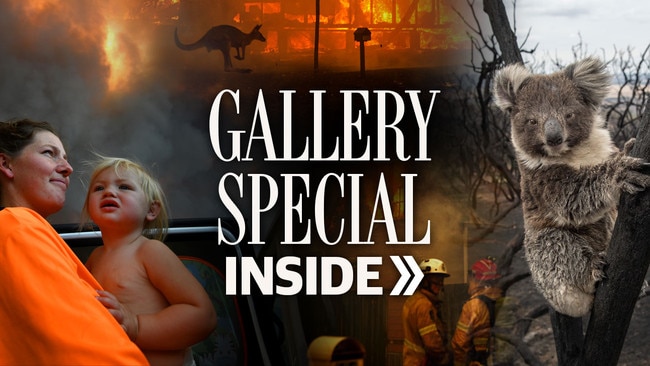NSW’s bushfire season was officially the worst on record
NSW’s most devastating bushfire season on record has officially ended, eclipsed by a new crisis — COVID-19. But with the 2020 fire season just months away, the RFS warns there’s no time for complacency as it reflects on a nightmare summer.
Bushfire Support
Don't miss out on the headlines from Bushfire Support. Followed categories will be added to My News.
- NSW Bushfire special: All the best coverage
- Mates under fire: Stories from the inferno
- New $1million fund for bushfire communities
A staggering one billion animals dead, five million hectares of land laid to waste, more than 2400 homes destroyed and tragically, 25 lives lost.
The NSW bushfire season — the most devastating in our history — officially ended yesterday.
NSW Rural Fire Service Commissioner Shane Fitzsimmons said the season, which began in some areas in August last year, was unprecedented in terms of the conditions experienced and the loss of lives and property.
Fire crews responded to more than 11,400 bush and grass fires that burnt more than 6.2 per cent of the state, destroyed 2448 homes.

With towns and communities still reeling from the killer infernos, attention has now turned to the invisible threat of COVID 19.
But Commissioner Fitzsimmons said our thoughts would forever be with the 25 people who died, including the three NSW RFS volunteers — Geoffrey Keaton and Andrew O’Dwyer from the Horsley Park Brigade and Samuel McPaul from the Morven Brigade — as well as American aerial firefighters Ian McBeth, Paul Hudson and Rick DeMorgan Jr.
“Their loss has been felt deeply and we honour the sacrifice they made to selflessly protect communities across NSW,” Commissioner Fitzsimmos said.
A BLACK SUMMER
Over the summer there were an unprecedented six days where areas across NSW recorded catastrophic fire weather conditions with an average of 2500 firefighters in the field each shift and up to 4000 on days of increased fire danger and impact.
Commissioner Fitzsimmons praised the combined inter-agency response from NSW RFS, Fire and Rescue NSW, National Parks and Wildlife Service, Forestry Corporation NSW, NSW State Emergency Service, NSW Police, NSW Ambulance and the Australian Defence Force as well as firefighters from interstate, New Zealand, the United States and Canada.
“We continue to thank our members’ families, colleagues and employers for allowing our volunteers to provide such a great level of protection to the people of NSW,” Commissioner Fitzsimmons said.

“Time and time again, we’ve heard from affected areas how the incredible work of firefighters on the ground, backed up by the crews in the air, have helped save people and property.”
He also praised the community for its response across the fire season.
“Responding to bushfires is a team effort, and the community across NSW is an important team member. We must also be mindful of all those still enduring the very raw and difficult recovery process as a result of the fires and that efforts are sustained through this very personal challenge.”

A NEW CRISIS
As the focus shifts to the coronavirus pandemic, Commissioner Fitzsimmons said he wanted to remind the public that the next bushfire season will begin in only a matter of months.
“Keep your property prepared and have your bushfire survival plan up to date and discussed with those in your family and household,” he said.
The statutory Bush Fire Danger Period normally starts on October 1, and continues through to the following 31 March.
However, last year’s early start continued a pattern of danger periods starting a month early and end a month later than normal. At least 20 other districts in NSW began their danger period early in 2019, and weather scientists have predicted that longer fire seasons could become more common in the years ahead.

A DEADLY HISTORY
The last NSW bushfires are among the worst and the longest in Australia’s history but the deadliest remain the Black Saturday fires of February 2009.
● Black Saturday blazes of February 2009 killed 173 people and burned through 450,000 ha across Victoria with more than 2000 homes destroyed.
● Ash Wednesday: In 1983, 75 people, including 17 firefighters, died in the Ash Wednesday bushfires that ripped through over 1.2 million hectares across South Australia and Victoria.
● In the 1974-75 bushfire season, approximately 15 per cent of Australia or 117 million hectares were decimated by fires across NSW, Queensland, the Northern Territory, South Australia and Western Australia.
● In the Black Friday bushfires of January 1939, blazes burned across 2 million hectares in Victoria killing 71 people and wiping out entire towns.
Originally published as NSW’s bushfire season was officially the worst on record

